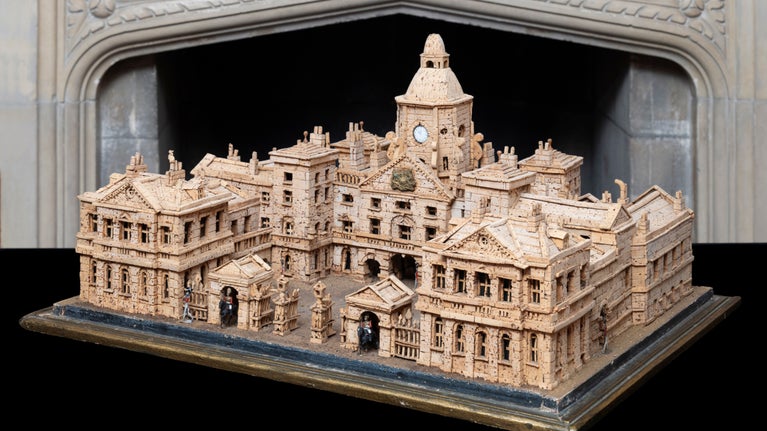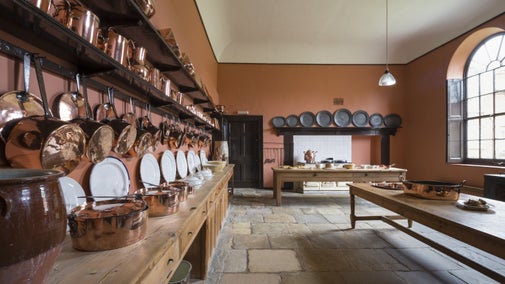
Art and collections
We care for one of the world's largest and most significant collections of art and heritage objects. Explore the highlights, our latest major exhibitions, curatorial research and more.

As British country houses grew in size from the 18th century onwards, new methods of communication evolved – from sprung bells to speaking tubes – which were used by members of the household to summon servants from distant quarters. Discover these innovations in communication technology that allowed one to call upon servants to make up fires, bring aperitifs or fetch hot water for the bath.
From the medieval period through the 17th century, the great hall was the social and emotional heart of the manor house. It was a communal space where the lives of nobles and their servants regularly intersected. The service areas adjoined the lower end of the hall, and as such, servants were easily called upon.
By the 18th century, however, country house design shifted to move servants – and their associated duties – out of sight. Houses grew in size and entirely separate service wings were added.
With the addition of service tunnels, basement walkways and any number of utility rooms, it became increasingly difficult to find servants to undertake specific tasks as required. As servants were no longer immediately visible, new ways of summoning them became necessary.

No object is more evocative of historic household communication than the sprung bell. This device, worked by a complex system of wires, allowed for a member of the household to pull a lever, thereby ringing a bell located in the service areas. The bells were typically mounted in stairwells, outside servants' quarters and, in some instances, inside servants’ rooms.
Each bell hung from a coiled spring so that a pendulum – also suspended from the spring – would continue to move even after the bell had stopped ringing. This way, servants had time to move from the service areas to the bell system to see where they were required.
Each bell was fixed to a larger board and was individually labelled with the name of the room to which it was wired. These labels could be repainted as the use – or occupant – of the room changed. The bells themselves were of different sizes and emitted different tones, thereby allowing servants to distinguish one bell from another.
The bells were operated by a variety of pulls and levers. The earliest bells were probably rung by embroidered strips of cloth or tapestry with a ring pull or tassel on the end. In bedrooms, such pulls were usually hung on each side of the bed, enabling occupants to summon a servant without leaving bed.
The bell handles themselves could be ordered to suit a room’s decorative scheme. The exposed portions might be made of bronze, brass, porcelain, china or cut glass.
How quickly the bells were answered, however, was often a matter of complaint, as illustrations from the period attest.

Electric bells, made possible by the invention of the battery, were introduced into country houses from the 1860s onwards. The bell itself made use of an electromagnet linked to an armature with a small hammer. When an electrical circuit was created, the electromagnet caused the armature to move and the attached hammer to strike the bell.
For servants, the heart of the electrical bell system was the indicator board: a shallow, glass-fronted case displaying small, named apertures. These corresponded to the rooms from which calls could be received. When a call came in, a bell close to the board rang and a coloured disc behind the aperture moved, thus indicating where a servant was required.
With electric bells, servants still needed to go to one of the indicator boards to see where they were needed and then go to that room to ascertain what was wanted. With the development of speaking tubes, members of the household could communicate their requirements directly to servants, making extra journeys unnecessary.
At the transmitting end, a cylinder mouthpiece enabled the speaker to communicate with the receiving end, where a plugged-in whistle sounded to attract the attention of the intended recipient.

Although speaking tubes enjoyed popularity throughout the second half of the 19th century, they lacked privacy and had a limited range. The arrival of the telephone in the 1880s provided the optimal solution for direct communication.
Some houses had extensive internal systems with their own switchboard. At Polesden Lacey, the Interphone enabled a caller to contact 10 different lines, each indicated on the radial line selector.
At Castle Drogo, for example, the telephone in the butler’s sitting room enabled the butler to transfer calls elsewhere in the house. These handsets were only for internal communication, but handsets with a dial enabling subscribers to connect to external exchanges were common from the 1920s.
Most of these systems were introduced to summon servants rather than to communicate with the outside world. For this reason, it is important to record and preserve the relics of bell systems, speaking tubes and early telephones so that we can appreciate the historic ways in which country houses operated.
You can find out more about how technology transformed country houses, from developments in kitchen technology to new ways to heat and light homes, in the book Technology in the Country House by Marilyn Palmer and Ian West.

We care for one of the world's largest and most significant collections of art and heritage objects. Explore the highlights, our latest major exhibitions, curatorial research and more.
Some of the historic kitchens we care for have catered for royalty, while others contain well-preserved stoves and gadgets from centuries past. Discover stories from some of the best kitchens to visit.

Learn about some of the misleading objects, paintings and architectural features in the historic houses we look after, and discover the truth behind these optical illusions.

From 18th-century mini palaces to entire model villages, discover the rare and exquisite dolls’ houses in the collections we care for.

Dummy boards, also called silent companions, are life-size, flat, wooden figures. Find out why they were popular in the 17th century and where you can see them at the places we care for.

How we think about servants is dominated by where they worked – the kitchens, stable blocks and sculleries. Discover where servants lived, and where you can see their rooms today.
